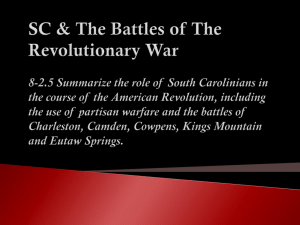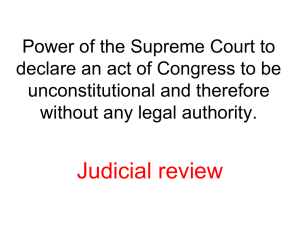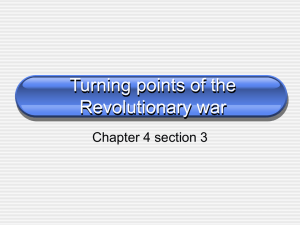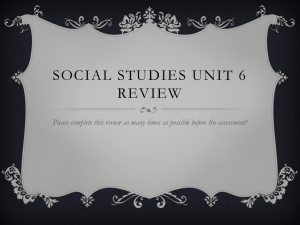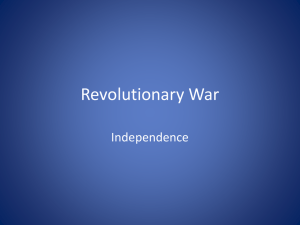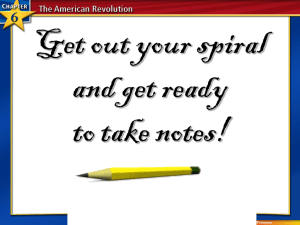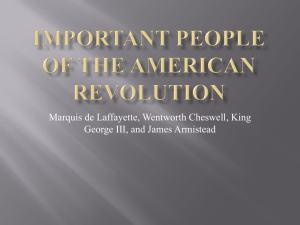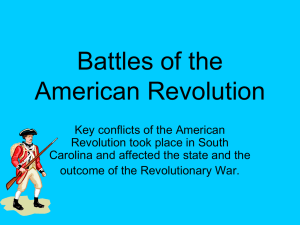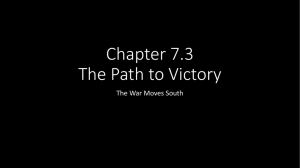8-2.5 Battles of the American Revolution
advertisement
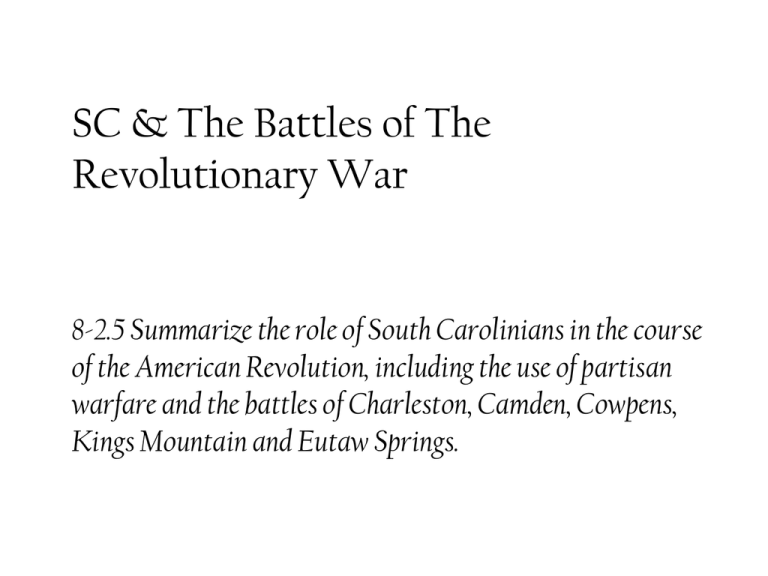
SC & The Battles of The Revolutionary War 8-2.5 Summarize the role of South Carolinians in the course of the American Revolution, including the use of partisan warfare and the battles of Charleston, Camden, Cowpens, Kings Mountain and Eutaw Springs. The Fighting Begins 1. Fighting began in 1775 in the Northern colonies. 2. Americans won a decisive victory at Saratoga, NY a) Turning point in war – Americans welcome alliance with France. battle of Saratoga – (9:32) Turning Point – Saratoga, NY Turning Point – Saratoga, NY The fighting continues… 1. 2. Key conflicts of the American Revolution took place in SC and affected the state and outcome of the War. Fighting began in 1775 in the Northern colonies, but after the British loss at Saratoga, they decided to try a new strategy…take the South. First Battle of Charleston 1. 2. 3. 4. 5. 6. Summer of 1776 British Gen. Clinton sent 5000 troops from Boston Patriot leaders got word the British planned to capture Charles Town. They decided to build a fort on Sullivan’s Island – Colonel William Moultrie began building a fort of palmetto logs. British fired and their cannon balls bounced safely off the soft wood. Americans severely damaged the British ships and renamed the fort, Fort Moultrie. Flag of SC… Sergeant Jasper lifting the flag after it had fallen in the battle---- Colonel Moultrie designed the flag that hung over Sullivan’s Island. It had a silver crescent in the corner. Today it also has a silver palmetto tree in honor of the victory. In 1861 it became the official state flag. First Battle of Charleston Siege of Charleston 1. 2. 3. 4. March 29, 1780 Major General Benjamin Lincoln severe blow to the colonies the greatest loss of manpower and equipment of the war for the Americans 5. gave the British nearly complete control of the Southern colonies British Mistreat Colonists British Response to SC 1. British hoped they would gain control of state through large numbers of state Loyalists and neutral colonists to help win the war 2. But, British changed their parole terms and forced paroled Patriots to take up arms against their countrymen a) At the same time, the British, along with American Tories, treated SC harshly: they burned churches, looted & confiscated homes, harassed and exiled citizens b) This behavior turned South Carolinians against the British. Partisan bands were formed as a result PARTISAN TROOPS SUMTER MARION PICKENS Partisan Troops 1. Patriot partisans led by Francis Marion, Thomas Sumter, Andrew Pickens, & William Harden a) fighting both the British regular troops and Loyalists forces using hit & run tactics all over the state (Guerilla Warfare) Battle of Camden 1. August 16, 1780 2. a major defeat for regular Continental Army; signified almost all of SC was controlled by British 3. SC militia was not prepared and turned and fled in the face of regular British forces Battle of Camden 1. 2. Horatio Gates’ commander of the southern arm of the Continental Army was transferred to Nathaniel Greene Greene understood need to coordinate with the work of the state’s partisans in order to fight a destructive war of attrition [termed today a “mobile war”] that would unbalance and eventually destroy the British war effort. British Troops after the Battle of Camden Battle of King’s Mountain Battle of Kings Mountain The Scotch-Irish and the Battle of Kings Mountain – YouTube (8:16) Battle of Kings Mountain 1. After British victory at Camden, Cornwallis sent Major Patrick Ferguson, Commander of Loyalists, into SC Up-country to rid area of Patriots. 2. Ferguson was ambushed by North & South Carolina mountain-men at Kings Mountain on October 7, 1780. 3. Using guerrilla warfare, Patriots killed Ferguson along with 1,100 of his men. 4. British tried to surrender, but were offered no quarter by Patriots in retaliation of harsh treatment British had bestowed upon Patriots throughout SC 5. Kings Mountain is considered turning point of war in the south. From this point on, British began retreating from interior of SC. Battle of King’s Mountain – The Turning Point in the War Battle of Cowpens Battle of Cowpens – YouTube (2:18) Battle of Cowpens 1. The Battle of Cowpens (Jan. 17, 1781) showed cooperation of regular Continental Army and partisan forces. 2. Partisans had a reputation of turning tail and running (think Camden Cowards). Americans counted on this rep for battle plan. 3. partisans, led by Andrew Pickens, led attack and then fled, tricking British into thinking Americans were retreating. Instead, partisans lured British forces into guns of regular American army. 4. British were defeated-retreated toward Virginia. Colonel Isaac Hayne 1. Partisan parolee Colonel Isaac Hayne was captured near Charleston in July 1781 2. British used his punishment as an example to help stem Patriot advance 3. They hanged him as a traitor of British crown after only a brief trial 4. Nathaniel Greene issued a proclamation stating he would retaliate against British forces. Battle of Eutaw Springs 1. 2. 3. 4. 5. September, 1781 Not the last of 137 battles fought in SC, nor a technical victory the irreplaceable British troop losses made it strategically the final major battle in SC While current sources often disagree in their final assessment of who won the battle itself, there is no question about its evaluation by the Patriot cause. American contemporaries viewed the Battle of Eutaw Springs in the very least as a Pyrrhic victory for British because it marked the clearance of the British from the battleground state and region (with the exception of a few coastal enclaves that were finally evacuated after Yorktown and during the peace proceedings in 1782) and thus the demise of the British southern campaign. Victory at Yorktown 1. 2. 3. After the British defeat at Cowpens, General Cornwallis was forced to leave SC and retreat to Yorktown, VA hoping to resupply his troops and later gain a better hold on the south. At this same time, Washington, with help from the French (Reminder: The French sided with ANYONE against the British), cut off Yorktown peninsula from the main land. French navy cut off peninsula by sea. 4. Cornwallis was held under siege for weeks. No supplies reached him because of the French naval blockade. 5. In early October, Patriots prepared for an attack on Cornwallis – his troops were weak from starvation. 6. Fearing defeat, Cornwallis surrendered October19, 1781, ending the Revolutionary War. Victory at Yorktown Liberty`s Kids #36 Yorktown – YouTube (21:37) Treaty of Paris 1. In June 1781, reps from the Continental Congress began peace negotiations with the British. 2. American delegates were John Jay, John Adams, Henry Laurens, & Benjamin Franklin. 3. The Treaty of Paris took 2 years to work out. 4. George Washington stated, “The citizens of America are…possessed of absolute freedom and independency.” Conditions/Provisions of the Treaty of Paris, 1783 1. Established British recognition of the United States. 2. Established the borders as north to the Great Lakes, west to the Mississippi River & south to Spanish Florida. 3. Allowed for Americans to settle west of the original 13 colonies. Review 1. Why was American victory at Saratoga so important? 2. Who were the three leaders of the Partisan Troops? 3. What battle was the turning point of the war in SC? 4. What made the Battle of Camden so unique?
